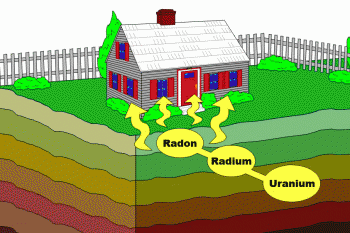 You may remember the saying, “Ignorance is bliss.” Choosing not to learn about things that could upset us may seem preferable in the short run. But it is also dangerous because not knowing does not reduce the risk. Take, for example, the potential health threat of underestimating Radon gas levels in the home.
You may remember the saying, “Ignorance is bliss.” Choosing not to learn about things that could upset us may seem preferable in the short run. But it is also dangerous because not knowing does not reduce the risk. Take, for example, the potential health threat of underestimating Radon gas levels in the home.
Radon gas is a naturally-occurring, radioactive gas that damages delicate lung tissue as people breathe contaminated air. Radon is proven to be a leading cause of lung cancer in non-smokers, and second only to smoking. The higher the level, and the longer the exposure to Radon, the greater the risk of disease.
Take, for example, the story of Gloria Linnertz, whose husband Joe was unexpectedly diagnosed with late-stage lung cancer, and six weeks later he died. This was a big shock to everyone who knew Joe, as had taken good care of his health. He exercised, followed a healthy diet, and did not smoke.
When their house was finally tested for Radon, the results showed the home where they had lived for 18 years contained more than four times the EPA action level of Radon, which is 4 picocuries per liter (pCi ). Gloria is a founder and president of Citizens for Radioactive Radon Reduction, which is increasing public awareness about Radon and urging testing so that people don’t learn the hard way about Radon and its dangers.
Elizabeth (Liz) Hoffmann, who never smoked and was never around secondhand smoke, was diagnosed with lung cancer. At the time, she had never heard of Radon. But testing of her house showed that it contained twice the EPA action level of Radon. In 2004, Liz founded CanSAR as a channel to speak out about the risks of Radon in the home, and to raise public and legislative awareness. She was diagnosed with more cancer, in her lungs and brain, in 2006, 2008 and 2010.
Tragically, many people have fallen victim of lung cancer, with about 21,000 per year in the U.S. dying from cancer, often because they hadn’t measured their Radon levels and were exposed to elevated Radon for years. There are no immediate symptoms that indicate disease or predict the cumulative effects of exposure. Many lung cancer patients do not discover their illness until it is in the final stages, where the five-year survival rate is just four percent – making the 10-year cancer battle of Liz Hoffman a miracle. Testing and mitigating Radon can be an effective way to make your home safer for all.
Levels of this invisible, odorless radioactive gas can vary from house to house, and from neighborhood to neighborhood. No matter the type home you have, whether it be old or new, brick or wood-frame, with a basement, crawl space or slab on grade, testing is always a good idea. Radon-induced lung cancer can be prevented. Abatement systems can lower the amount of Radon in the home to a much safer level, per EPA standards.
If you are buying or selling a house, or if you are an owner who just wants to know the current risk to the health of your loved ones, we encourage you to be proactive and hire HouseMaster Home Inspections to test and measure the level of Radon in your home.
You can read more about what Radon is, where it comes from and how it enters a house:
https://www.radon.com/radon_facts/
SOURCES:
https://airthings.com/us/gloria-linnertz/
http://www.cansar.org/
Note: These tips are only general guidelines. Since each situation is different, contact a professional if you have questions about a specific issue. More home safety and maintenance information is available online at www.housemaster.com.